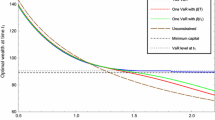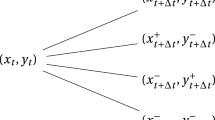Abstract
We analyze the impact of policyholder behavior on pricing, hedging and hedge efficiency of variable annuities with guaranteed lifetime withdrawal benefits. We consider different product designs, market models and approaches for modeling policyholder behavior in our analyses, covering deterministic behavior, behavior depending on the ‘moneyness’ of the guarantee, and optimal (value maximizing) behavior. First, we assess the risk of mispricing the guarantee due to inaccurate assumptions regarding future policyholder behavior. Comparing products with different ratchet mechanisms, we find that this potential for mispricing is the smallest for the product design with the most valuable ratchet mechanism. We further quantify the impact of different behavior models on the efficiency of the insurer’s hedging strategy and the risk that results if the insurer’s assumption for policyholder behavior deviates from actual behavior. Our analyses indicate significant differences between the considered products in terms of hedgeability and the sensitivity of the guarantee’s value towards policyholder behavior and towards changes in the underlying asset’s volatility. Also, we show that a simple path-dependent behavior model may not be suitable to fully assess the risk arising from policyholder behavior.
Similar content being viewed by others
Notes
Note that the client can choose to withdraw less than the guaranteed amount, thereby increasing the probability of future ratchets. If the client wants to withdraw more than the guaranteed amount, any exceeding withdrawal would be considered a partial surrender.
For details on partial surrender, we refer the reader to Bauer et al. [6].
References
American Academy of Actuaries (2005) Recommended approach for setting regulatory risk-based capital requirements for variable annuities and similar products. American Academy of Actuaries, Boston
Bacinello AR (2003) Fair valuation of a guaranteed life insurance participating contract embedding a surrender option. J Risk Insur 70:461–487
Bacinello AR (2005) Endogenous model of surrender conditions in equity-linked life insurance. Insur Math Econ 37(2):270–296
Bacinello AR, Biffis E, Millossovich P (2010) Regression-based algorithms for life insurance contracts with surrender guarantees. Quant Financ 10:1077–1090
Bacinello AR, Millossovich P, Olivieri A, Pitacco E (2011) Variable annuities: a unifying valuation approach. Insur Math Econ 49(3):285–297
Bauer D, Kling A, Ruß J (2008) A universal pricing framework for guaranteed minimum benefits in variable annuities. ASTIN Bull 38(2):621–651
Bernard C, MacKay A, Muehlbeyer M (2014) Optimal surrender policy for variable annuity guarantees. Insur Math Econ 55(1):116–128
Bingham NH, Kiesel R (2004) Risk-neutral valuation: pricing and hedging of financial derivatives. Springer, Berlin
Black F, Scholes M (1973) The pricing of options and corporate liabilities. J Polit Econ 81:637–654
Chen Z, Vetzal K, Forsyth PA (2008) The effect of modelling parameters on the value of GMWB guarantees. Insur Math Econ 43(1):165–173
Cox JC, Ingersoll JE, Ross SA (1985) A theory of the term structure of interest rates. Econometrica 53:385–407
DAV (2004) Herleitung der DAV-Sterbetafel 2004 R für Rentenversicherungen. Deutsche Aktuarvereinigung. http://aktuar.de/custom/download/dav/veroeffentlichungen/2004-UAG-Rentnersterblichkeit-DAV-2004R.pdf. Accessed 23 Mar 2012
De Giovanni D (2010) Lapse rate modeling: a rational expectation approach. Scand Actuar J 1:56–67
Eraker B (2004) Do stock prices and volatility jump? Reconciling evidence from spot and option prices. J Financ 59:1367–1403
Ewald C-O, Poulsen R, Schenk-Hoppe KR (2009) Risk minimization in stochastic volatility models: model risk and empirical performance. Quant Financ 9(6):693–704
Gao J, Ulm ER (2012) Optimal consumption and allocation in variable annuities with guaranteed minimum death benefits. Insur Math Econ 51(3):586–598
Grosen A, Jorgensen P (2000) Fair valuation of life insurance liabilities: the impact of interest rate guarantees, surrender options, and bonus policies. Insur Math Econ 26:37–57
Heston S (1993) A closed form solution for options with stochastic volatility with applications to bond and currency options. Rev Financ Stud 6(2):327–344
Holz D, Kling A, Ruß J (2012) GMWB for life—an analysis of lifelong withdrawal guarantees. Z für die Gesamte Versich 101(3):305–325
ING (2011) Press release. http://www.ing.com/Our-Company/Press-room/Press-release-archive/PressRelease/ING-to-take-EUR-0.91.1-billion-4Q-charge-on-US-Insurance-Closed-Block-VA-assumption-review.htm. Accessed 23 Mar 2012
Kling A, Ruez F, Ruß J (2011) The impact of stochastic volatility on pricing, hedging, and hedge efficiency of withdrawal benefit guarantees in variable annuities. Astin Bull 41(2):511–545
Knoller C, Kraut G, Schoenmaekers P (2013) On the propensity to surrender a variable annuity contract: an empirical analysis of dynamic policyholder behavior. In: Working paper, Munich Risk and Insurance Center
Longstaff FA, Schwartz ES (2001) Valuing American options by simulation: a simple least-squares approach. Rev Financ Stud 14(1):113–147
Manulife Financial (2011) Press release. http://www.manulife.com/public/files/201/1/MFC_3Q11_PR.pdf. Accessed 23 Mar 2012
Milevsky M, Salisbury TS (2006) Financial valuation of guaranteed minimum withdrawal benefits. Insur Math Econ 38:21–38
Steffensen M (2002) Intervention options in life insurance. Insur Math Econ 31(1):71–85
Sun Life Financial (2011) Press release. http://www.sunlife.com/static/global/files/News%20Releases%202011%20PDFs/pa_e_Sun_Life_Financial_reports_third_quarter_2011_results_Nov2.pdf. Accessed 23 Mar 2012
The Hartford (2009) 1st quarter 2009 stakeholder message of The Hartford. http://www.thehartford.com/higfiles/pdf/1Q09_Ramani_Message.pdf. Accessed 10 Mar 2014
Wong B, Heyde CC (2006) On changes of measure in stochastic volatility models. J Appl Math Stoch Anal 2006:1–13
Yang SS, Dai T-S (2013) A flexible tree for evaluating guaranteed minimum withdrawal benefits under deferred life annuity contracts with various provisions. Insur Math Econ 52(2):231–242
Author information
Authors and Affiliations
Corresponding author
Rights and permissions
About this article
Cite this article
Kling, A., Ruez, F. & Ruß, J. The impact of policyholder behavior on pricing, hedging, and hedge efficiency of withdrawal benefit guarantees in variable annuities. Eur. Actuar. J. 4, 281–314 (2014). https://doi.org/10.1007/s13385-014-0093-0
Received:
Revised:
Accepted:
Published:
Issue Date:
DOI: https://doi.org/10.1007/s13385-014-0093-0




